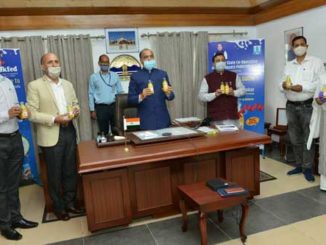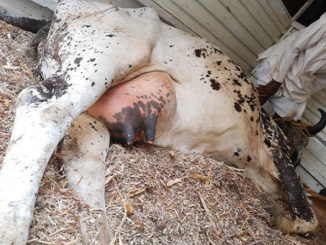Milk is considered to be the “Ideal food” because of its abundant nutrients required by both infants and adults. It is one of the best sources for Protein, Fat, Carbohydrate, Vitamin and Minerals. Unfortunately milk is being very easily adulterated throughout the world. Possible reasons behind it may include- demand and supply gap, perishable nature of milk, low purchasing capability of customer and lack of suitable detection tests.

Qualitative detection of adulterants in milk can be easily performed with chemical reactions while quantitative detections are complex and diverse. Type of quantitative detection techniques depend on the nature of adulterants in milk. For example, LC (Liquid Chromatography) and ELISA (Enzyme Linked Immunosorbent Assay) are the most common techniques used to detect foreign protein; PCR (Polymerase Chain Reaction) and PAGE (Polyacrylamide Gel Electrophoresis) are usually used to detect milk from different species as adulterants in milk of a particular species
Milk powder is the second most likely food item being in the risk of adulteration after olive oil. Adulterants in milk mainly include addition of vegetable protein, milk from different species, addition of whey and watering which are known as economically motivated adulteration.
Rapid qualitative detection of different Edible Adulterants in Milk
| Adulterant | Procedure | Observation |
|
Sugar |
Take 5 mL milk sample in a test tube. Add 1 mL conc. HCl and 0.1 g resorcinol solution. Place the test tube in water bath for 5 min | Appearance of red color indicates the presence of added sugar. |
|
Starch |
Take 3 mL sample in a test tube. After boiling it thoroughly, cool it to room temperature. Add 1 drop of 1% iodine solution. | Appearance of blue color indicates the presence of starch. |
|
Glucose |
Take 1 ml of milk sample in a test tube. Add 1 ml of modified Barfoed’s reagent. Heat the mixture for exact 3 min in a boiling water bath. Rapidly cool under tap water. Add one ml of phosphomolybdic acid reagent to the turbid solution. | Immediate appearance of deep blue color indicates the presence of glucose. |
|
Common salt |
Take 5 ml of milk sample into a test tube. Add 1 ml of 0.1 N silver nitrate solution. Mix the content thoroughly and add 0.5 ml of 10% potassium chromate solution | Appearance of yellow color indicates the presence of added salts, whereas,brick red color indicates the milk free from added salt. |
|
Buffalo milk |
Dilute the milk 1/10. Put a drop of diluted milk on the centre of a glass slide. Now place a drops of Hansa test serum (duly preserved) on the drop of milk and mix together with a glass rod | Curdy particles develop within half a
minute in milk containing buffalo milk. |
Rapid qualitative detection of different hazardous chemicals in milk
| Adulterant | Procedure | Observation |
|
Hydrogen Peroxide
|
Add to 5 mL of suspected milk sample in attest tube, an equal volume of raw milk and 5 drops of 2% solution of Paraphenylenediamine. | Appearance of blue color indicates the presence of hydrogen peroxide as adulterant |
| Take 1 mL milk sample in a test tube and add 1 mL of potassium iodide-starch reagent solution and mix well. | Appearance of blue color indicates the presence of hydrogen peroxide as adulterant. | |
|
Formalin |
Take 10 mL milk sample in attest tube.Add 5 mL conc. sulfuric acid with a little amount of ferric chloride | Appearance of violet or blue color at the junction of two liquid layers indicates the presence of formalin. |
| Take about 5 ml of milk in a test tube.Take 1 ml of 10% ferric chloride solution in a 500 ml volumetric flask and make up
the volume using concentrated hydrochloric acid. Add 5 mL from this solution to the sample in test tube.Keep the tube in boiling water bath for about 3-4 min. |
Appearance of brownish pink color indicates the presence of formalin. | |
| Take 1 mL of sample milk in a test tube.Take saturated solution of 1, 8-dihydroxynaphthalene-3, 6- disulphonic acid in about 72% sulfuric acid to make chromotropic acid solution. Add 1 Ml of chromotropic acid solution to the sample in test tube. | Appearance of brownish pink color indicates the presence of formalin. | |
|
Ammonium sulfate |
Take 2 ml. milk in a test tube and add 0.5 ml NaOH (2%) 0.5 ml sodium hypochlorite (2%) and 0.5 ml phenol (5%) Heat in boiling water bath for 20 sec | A bluish colour forms immediately, which turns deep blue afterward. Pure milk shows salmon pink colour which gradually changes to bluish after 2 hours. |
| Take 10 ml of milk in a 50 ml stoppered test tube. Add 10 ml of TCA solution. Filter the coagulated milk through Whatman filter paper Grade 42. Take 5 ml of clear filtrate. Add few drops of barium chloride solution. | Formation of milky-white precipitates indicates the presence of added sulfates like ammonium sulfate, sodium sulfate, zinc sulfate and magnesium sulfate etc. to milk
|
|
Urea |
Take 5 mL milk sample in a test tube. Add equal volume of 24% TCA to precipitate fat and proteins of milk. Take 1 mL filtrate and add 0.5 mL 2% sodium hypochlorite, 0.5 mL 2% sodium hydroxide and add 0.5 mL 5% phenol solution, then mix. | A characteristic blue or bluish green colour develops in presence of added urea whereas pure milk remains colourless. |
| Take 5 ml milk in a test tube, add 0.2 ml urease (20 mg/ml) Shake well at room temperature and then add 0.1 ml Bromothymol Blue (BTB) solution (0.5%) | Appearance of blue colour after 10-15 min. indicates the presence of urea in milk. Normal milk shows faint blue colour due to natural urea present in milk. | |
| Take 5 mL milk sample in a test tube. Add 5 mL p-Dimethyl Amino Benzaldehyde reagent. | Appearance of distinct yellow color indicates presence of added urea whereas formation of slight yellow color indicates natural urea in milk. | |
|
Nitrate |
Take 10 ml sample milk in a beaker. Add 10 ml mercuric chloride solution to it. After mixing, filter through what man No 42 filter paper. Take 1 ml filtrate in a test tube and add 4 ml of diphenylamine sulphate or diphenylbenzidine reagent. | Appearance of blue colour indicates the presence of nitrates. Pure milk sample will not develop any color. |
|
Benzoic and salicylic acid |
Take 5 mL milk sample in a test tube. Upon acidification with sulfuric acid, 0.5% ferric chloride solution is added to it drop by drop. Mix it. Five ml of milk is taken in a test tube and acidified with con. sulphuric acid. 0.5% ferric chloride solution is added drop by drop and mixed well. Development of buff colour indicates presence of benzoic acid and violet colour indicates salicylic acid. | Appearance of buff color indicates the presence of benzoic acid whereas that of violet color indicates salicylic acid. |
|
Borax and Boric acid |
Take 5 mL milk sample in a test tube. Add 1 mL conc. HCl to it. A turmeric paper is dipped and it is dried in a watch glass at 100 °C. | If the turmeric paper turns red, it indicates the presence of borax or boric acid. |
Rapid qualitative detection of different mixed adulterants in milk
| Adulterant | Procedure | Observation |
|
Detergent |
Take 5 ml in a test tube and add 0.1 ml 0.5% Bromocresol Purple (BCP) solution | Appearance of violet colour indicates the presence of detergent. Unadulterated milk shows faint violet color. |
| Take 5 mL of milk sample into a 15 Ml test tube. Add 1 ml of Methylene blue dye solution and 2 ml chloroform. Vortex the contents for about 15 sec and centrifuge at about 1100 rpm for 3 min | Relatively, more intense blue color in lower layer indicates presence of detergent in milk. Relatively more intense blue color in upper layer indicates absence of detergent in milk. | |
|
Pulverized soap |
Take 10 ml milk sample in a test tube. Add equal quantity of hot water to it, then add 1 – 2 drops of phenolphthalein indicator. | Appearance of pink color indicates presence of soap. |
|
Coloring matter |
Take 10 mL milk sample in attest tube.Add 10 ml diethyl ether. After shaking, allow it to stand | Appearance of yellow color in ethereal layer indicates the presence of added color |
| Make the milk sample alkaline with sodium bicarbonate. Dip a strip of filter paper for 2 hours | Appearance of red color on filter paper indicates the presence of annatto. Treatment of this paper with stannous chloride gives pink color | |
| Add a few drops of hydrochloric acid to milk sample. | Appearance of pink color indicates azo dyes. |







Be the first to comment